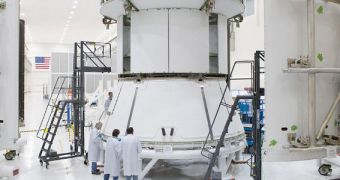Officials with the American space agency announced last Friday, March 14, that the expected date for the first test flight of the new Orion Multi-Purpose Crew Vehicle (MPCV) has been pushed back by around three months from its original launch date. An official reason for the delay has not been provided, but a proposal has already been set forth unofficially.
According to some analysts, The US Air Force (USAF) needs to launch two recently declassified space surveillance satellites starting in September. Both spacecraft are part of the Geosynchronous Space Situational Awareness Program, which is meant to detect and track enemy satellites flying in high and very high orbits around Earth.
Delaying the launch of Orion's Exploration Flight Test-1 (EFT-1) may have been caused by the need to launch both of these satellites ahead of schedule. However, the USAF and NASA are highly unlikely to comment on these rumors. Experts with the space agency have already announced that the spacecraft will most likely be ready within the original time frame, by late September.
According to a statement on the NASA website, the launch of EFT-1 was delayed “to early December to support allowing more opportunities for launches this year. The Orion team continues to work toward completing the spacecraft to be ready for a launch in September – October.”
Other than this delay, plans for the capsule's maiden flight remain the same. The Orion flight prototype is scheduled to launch aboard a United Launch Alliance (ULA) Delta IV Heavy delivery system, from the Cape Canaveral Air Force Station in Florida. The spacecraft will then reach an altitude of about 5,800 kilometers (3,600 miles), the farthest a potentially-manned vehicle reached in the last 40 years.
NASA has big plans for Orion. A manned version of the capsule is scheduled to fly a mission around the Moon sometime in 2021, while another spacecraft will visit a near-Earth asteroid by 2025. The current US Space Policy calls for American astronauts to land on Mars using this vehicle sometime beyond 2030, Space reports.
However, EFT-1 will not feature a crew. The test capsule will be filled with instrumentation meant to provide engineers on the ground with sufficient data to refine the design of the capsule. The flight will also test whether or not the vehicle can withstand reentering Earth's atmosphere at a speed of 32,200 kilometers (20,000 miles) per hour, under very intense heat.
Orion will fly for the first time atop NASA's new rocket, the Space Launch System, in late 2017. The Delta IV Heavy that will be used for this year's flight is a just a replacement for the SLS.
“Completing the [Orion] according to the original schedule will allow many engineers and technicians to continue ...to work on the Orion spacecraft that will fly atop the agency's Space Launch System. It will also ensure that NASA's partners are fully ready for the launch of EFT-1 at the earliest opportunity on the manifest,” the NASA statement concludes.

 14 DAY TRIAL //
14 DAY TRIAL //